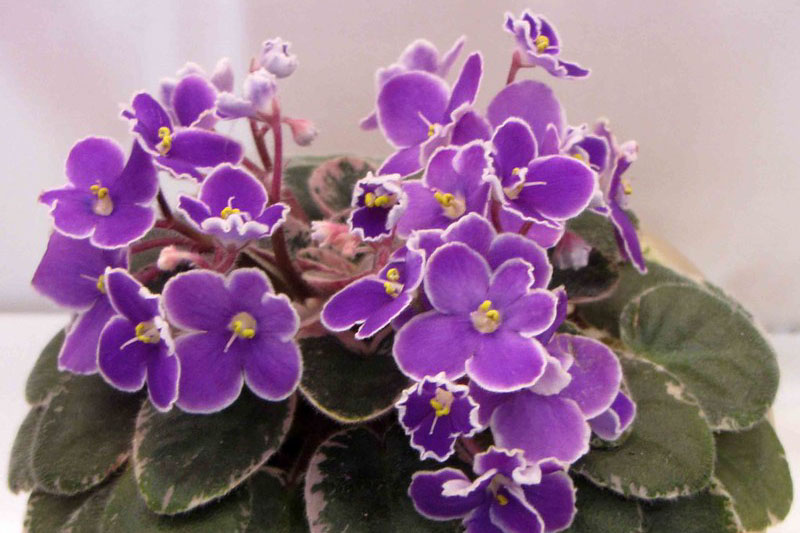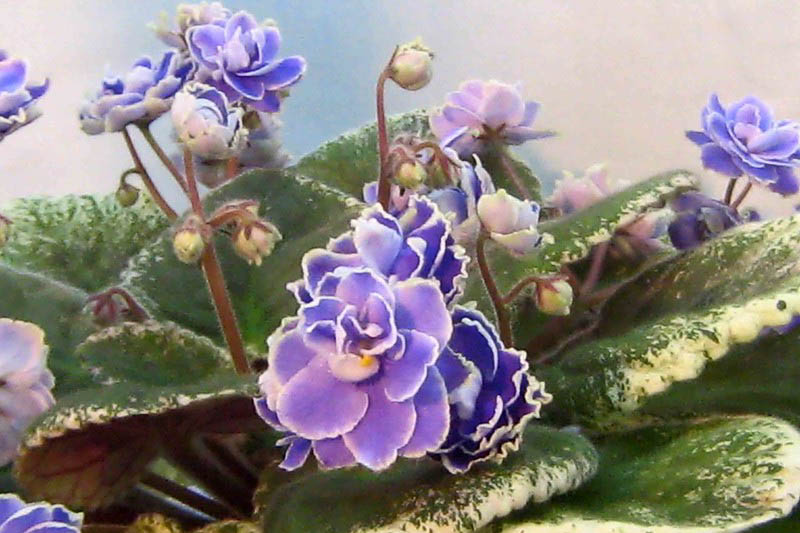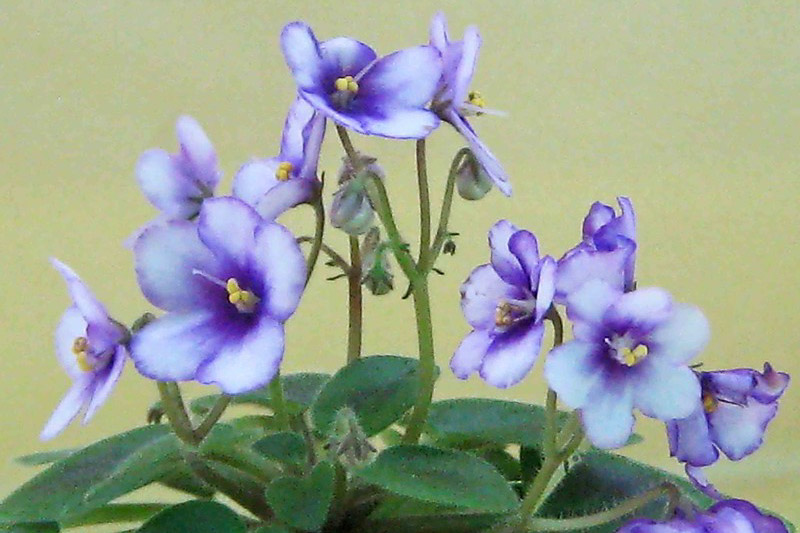African Violet, Streptocarpus ionanthus, Saintpaulia tongwensis
Saintpaulia ionantha, more commonly known as the African violet, is a captivating houseplant prized for its lush, velvety leaves and vibrant, petite flowers that can bloom throughout the year. Its rosette form, combined with its adaptability to indoor conditions, has made it a beloved choice for plant enthusiasts and novices alike.
Native: This captivating plant hails from the cloud forests of Tanzania and Kenya, thriving in the understory with filtered light and high humidity. It is fairly long-lived with a life span up to 50 years.
Habit: African violet is a compact, evergreen perennial exhibiting a rosette growth habit with leaves emerging in a circular arrangement around the plant’s center. Its petite nature adds to its charm, allowing it to grace windowsills, desktops, and other small spaces.
Size: African violets generally span from 6 to 18 inches (15-45 cm) in both height and width, depending on the cultivar and growing conditions.
Flowers: Its flowers are its crowning glory, appearing in hues of blue, purple, pink, or white. Some cultivars may even showcase bicolored or multicolored blooms, further enhancing their visual appeal. African Violets can bloom 10-12 months a year.
Hardiness: This plant thrives in USDA hardiness zones 11-12. However, it’s primarily grown as a houseplant in temperate regions due to its sensitivity to cold.
Uses: Given its compact size and striking flowers, the African violet makes an excellent tabletop plant. It’s also popular in terrariums and mixed indoor plant arrangements.
Toxicity: Good news for pet owners: African violets are non-toxic to both cats and dogs. However, as with any plant, it’s advisable to place it out of reach of curious pets to prevent any digestive upset or potential damage to the plant.
Benefits:
 Saintpaulia ‘Pat Champagne’ (African Violet)
Saintpaulia ‘Pat Champagne’ (African Violet)
African violets have been a staple in homes for generations, delighting with their velvety foliage and radiant blooms. Their charm lies not just in their beauty, but also in their relatively straightforward care requirements. Here’s a comprehensive guide on nurturing these vibrant houseplants:
African violets prefer bright, indirect light. East-facing windows are ideal, offering morning sunlight without the harsh intensity of the afternoon. If natural light is limited, fluorescent grow lights can suffice. Ensure they receive about 10-12 hours of light daily. Too little light can cause elongated, thin leaves, while too much might lead to bleached or scorched foliage.
Water is crucial, but overwatering can be detrimental. Let the topsoil dry out between waterings. When you water, use room-temperature water to avoid shocking the plant. To prevent leaf spotting, water the soil directly, ensuring that water doesn’t splash on the leaves. Alternatively, bottom-water by filling the saucer beneath the pot and allowing the roots to absorb water upwards.
A well-draining potting mix, specifically designed for African violets, is crucial. Repot your plant annually or when it outgrows its container. When choosing a pot, ensure it has drainage holes to prevent waterlogging.
Originating from tropical regions, African violets thrive in higher humidity. If your home’s air is dry, consider placing a humidifier nearby or positioning the plant on a tray filled with water and pebbles. The evaporating water increases ambient humidity.
They prefer temperatures between 65-75°F during the day (18-24°C) and a slight drop, about 10 degrees cooler, at night. Avoid sudden temperature changes, which can stress the plant.
Feed with a balanced, water-soluble fertilizer specifically designed for African violets every 2 weeks. Remember the golden rule: it’s better to under-fertilize than over-fertilize.
Remove faded flowers and yellowing leaves to encourage new growth and maintain the plant’s aesthetic appeal. This also helps in preventing potential disease and pest issues.
African violets can be propagated from leaf cuttings. Cut a healthy leaf with its stem, and insert it into a pot with African violet mix. With consistent moisture and warmth, it’ll root in a few weeks, giving birth to new plants.
Allow the plant to have a natural dormancy period during the fall and winter. During this time, reduce watering and limit fertilization to promote rest and prepare for new growth in the spring.
 Saintpaulia ‘Sansoucy Coco’ (African Violet)
Saintpaulia ‘Sansoucy Coco’ (African Violet)
African violets (Saintpaulia ionantha) are generally easy to care for, but they are not immune to pests and diseases. Here’s an overview of the most common issues you might encounter:
To keep your African violets healthy:
With proper care, vigilance, and timely intervention, your African violets can thrive and remain free from the most common pests and diseases.
 Saintpaulia ‘Rob’s Penny Ante Sport’ (African Violet)
Saintpaulia ‘Rob’s Penny Ante Sport’ (African Violet)
To encourage prolific blooming, ensure that your African violet gets adequate light. If your plant isn’t flowering, it might be receiving either too much or too little light. Adjusting its position might do the trick.
Keeping African violets blooming all year requires a harmonious balance of the right conditions. Firstly, provide bright, indirect light, ideally using a grow light for 12-14 hours daily. Consistently maintain temperatures between 65-75°F (18-24°C). Use a high-phosphorus fertilizer every 2 weeks to encourage blossoms. Ensure the soil is well-draining and water when it feels dry an inch below the surface, using lukewarm water to avoid shocking the roots. Water from the bottom, ensuring leaves remain dry. Finally, deadhead spent blooms to stimulate new flower production, and periodically inspect for pests, which can deter blooming.
When it comes to African violets, misting is not recommended. Here’s why:
Instead of misting, if you want to increase humidity for your African violets:
Remember, while African violets appreciate higher humidity, it’s essential to ensure the leaves remain dry to keep the plant healthy and aesthetically pleasing.
While it’s generally recommended to avoid touching African violet leaves unnecessarily, light and gentle handling is usually fine. Excessive touching or rough handling can potentially damage the delicate leaves.
African violets are easy to keep alive, primarily when provided with the right care. They require consistent attention to light, watering, humidity, and temperature to ensure their well-being.
Watering frequency depends on various factors such as temperature, humidity, pot size, and soil type. Generally, you should water African violets when the top inch of the soil feels dry to the touch. It’s essential to water from below by placing the pot in water and letting the plant soak up moisture through the roots, as getting the leaves wet can encourage diseases.
| Hardiness |
11 - 12 |
|---|---|
| Heat Zones |
10 - 12 |
| Plant Type | Houseplants, Perennials |
| Plant Family | Gesneriaceae |
| Genus | Streptocarpus |
| Exposure | Partial Sun |
| Season of Interest |
Spring (Early, Mid, Late) Summer (Early, Mid, Late) Fall Winter |
| Height |
6" - 2' (15cm - 60cm) |
| Spread |
6" - 2' (15cm - 60cm) |
| Maintenance | Average |
| Water Needs | Average |
| Soil Type | Sand |
| Soil pH | Acid, Neutral |
| Soil Drainage | Moist but Well-Drained |
| Characteristics | Showy, Evergreen |
| Garden Uses | Patio And Containers |
| Hardiness |
11 - 12 |
|---|---|
| Heat Zones |
10 - 12 |
| Plant Type | Houseplants, Perennials |
| Plant Family | Gesneriaceae |
| Genus | Streptocarpus |
| Exposure | Partial Sun |
| Season of Interest |
Spring (Early, Mid, Late) Summer (Early, Mid, Late) Fall Winter |
| Height |
6" - 2' (15cm - 60cm) |
| Spread |
6" - 2' (15cm - 60cm) |
| Maintenance | Average |
| Water Needs | Average |
| Soil Type | Sand |
| Soil pH | Acid, Neutral |
| Soil Drainage | Moist but Well-Drained |
| Characteristics | Showy, Evergreen |
| Garden Uses | Patio And Containers |
How many Saintpaulia ionantha (African Violet) do I need for my garden?
| Plant | Quantity | |
|---|---|---|
| Saintpaulia ionantha (African Violet) | N/A | Buy Plants |
Create a membership account to save your garden designs and to view them on any device.
Becoming a contributing member of Gardenia is easy and can be done in just a few minutes. If you provide us with your name, email address and the payment of a modest $25 annual membership fee, you will become a full member, enabling you to design and save up to 25 of your garden design ideas.
Join now and start creating your dream garden!
Create a membership account to save your garden designs and to view them on any device.
Becoming a contributing member of Gardenia is easy and can be done in just a few minutes. If you provide us with your name, email address and the payment of a modest $25 annual membership fee, you will become a full member, enabling you to design and save up to 25 of your garden design ideas.
Join now and start creating your dream garden!